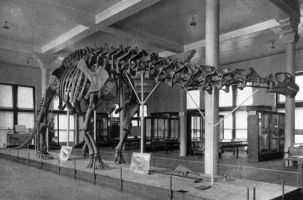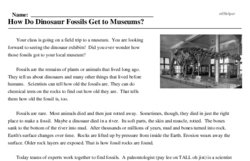How Do Dinosaur Fossils Get to Museums?
Your class is going on a field trip to a museum. You are looking forward to seeing the dinosaur exhibits! Did you ever wonder how those fossils got to your local museum?
Fossils are the remains of plants or animals that lived long ago. They tell us about dinosaurs and many other things that lived before humans. Scientists can tell how old the fossils are. They can do chemical tests on the rocks to find out how old they are. That tells them how old the fossil is, too.
Fossils are rare. Most animals died and then just rotted away. Sometimes, though, they died in just the right place to make a fossil. Maybe a dinosaur died in a river. Its soft parts, the skin and muscle, rotted. The bones sank to the bottom of the river into mud. After thousands or millions of years, mud and bones turned into rock. Earth's surface changes over time. Rocks are lifted up by pressure from inside the Earth. Erosion wears away the surface. Older rock layers are exposed. That is how fossil rocks are found.
Today teams of experts work together to find fossils. A paleontologist (pay lee on TALL oh jist) is a scientist who studies ancient life on Earth-things like the fossils of plants and animals. A geologist is a scientist who can tell the age of rocks and fossils. Draftsmen draw pictures of the fossils. Workers dig the fossil out of the rock. Photographers take pictures of the find. Specialists prepare the fossil for the museum.
In some places like Wyoming, fossils can be found lying on top of the ground. Usually, though, they are much harder to get to. Fossil hunters search along rivers and in rock quarries where digging has uncovered older rocks. Some fossil hunters climb high cliffs or down the sides of steep canyons. When highways and railroads are built, rock is often cut or blasted away. This helps expose older rocks. Road cuts are good places to look for fossils.




